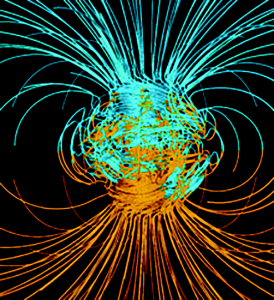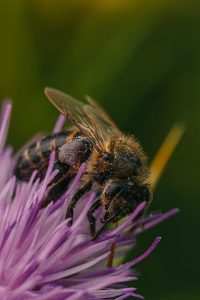By Clarence Collison
HONEY BEES AND MAGNETIC FIELDS
Is there a pull?
Over the years scientists have been interested in determining the effect of electromagnetic energy on colonies placed near power lines, on individual dancing and foraging behavior and recently the effect of cell phone towers on colony collapse disorder (CCD).
Honey bees orient to the earth’s magnetic field. This ability may be associated with a region of transversely oriented magnetic material in the front of the abdomen. The magnetic moment apparently develops in the pupal state and persists in the adults (Gould et al. 1978). There are at least three general mechanisms which might be used by animals to detect the earth’s magnetic field. The first requires the organism to possess a device to measure the charge separation that is induced when it moves through the earth’s field. A second method of detection might be accomplished by using permanent magnets that like compass needles produce a measurable torque as they attempt to twist into alignment with the earth’s field. The third strategy would require the organism to have paramagnetic substances-molecules which, in the presence of an external field, produce additional magnetism parallel to the external field. In order for this hypothesis to be involved, the animal would need to possess superparamagnetic domains – tiny ferromagnetic crystals which easily align their magnetism in the direction of the applied field. Evidence has been found in honey bees which favors this last possibility (Gould et al. 1980).
Honey bees have the ability to detect small fluctuations in the Earth’s magnetic field. Behavioral studies with worker honey bees have revealed four reproducible effects of magnetic fields on orientation. 1)There are small Missweissungs, or misdirections, in the waggle dance which can be changed by altering external magnetic fields around the comb (Kuterbach and Wolcott 1986a). In their dances, bees convert the angle flown to the food with respect to the sun into an angle danced in respect to gravity. In this conversion, bees make small regular errors which depend largely on the orientation of the dance with respect to the earth’s field. Cancelling the field causes the errors to disappear (Gould et al. 1978). 2)Honey bees will, in the absence of other external cues, build new comb in the same magnetic direction as the parent hive (De Jong 1982). 3)When placed on a horizontal comb, honey bee dancers will gradually over time orient to the four cardinal points of the magnetic compass. 4)Honey bees can set their circadian rhythms to the earth’s geomagnetic fluctuations (Gould 1980). More recently, Walker and Bitterman (1985) have reported that honey bees can be trained to discriminate between magnetic fields of different intensities. Although this behavioral evidence suggests that honey bees can detect weak earth-strength magnetic fields, the sensory system involved in this behavior is not fully understood.
Honey bees are sensitive to earth strength magnetic fields and are reported to contain magnetite (Fe3O4) in their abdomens. Kuterbach et al. (1982) reported bands of cells around each abdominal segment that contain numerous electron-opaque, iron-containing granules. The iron is principally in the form of hydrous iron oxides rather than crystalline magnetite. However, it is a form which is a direct precursor of magnetite. Further examinations found particulate iron within the trophocytes (cells associated with the fat body with a nutritional function) of the fat body of the adult bee (Kuterbach and Wolcott 1986a). These iron granules differed in their structure and composition from iron granules found in other biological systems. The granules had an average diameter of 0.32 ± 0.07 µm and were composed of iron, calcium and phosphorus in a non-crystalline arrangement. The granules were apparently randomly distributed within the cytoplasm of the cells, and were not associated with any particular cellular organelle. Electron microscopy revealed the presence of cell junctions between the trophocytes. Small gaps were seen between the outer leaflets of the cells forming the cell junction. Physiological studies showed that these cells are electrically coupled, but the coupling ratio is low, as a result of extensive coupling to many cells.
 The development of iron granules in honey-bee tissues was further investigated by Kuterbach and Walcott (1986b) using both anatomical and analytical methods. Iron granules are present only in the trophocytes of post-eclosion adults and have the same elemental composition as those in foraging adults. The granules increase in both size and number during ageing. Iron levels in developing worker honey bees were measured by proton-induced X-ray emission spectroscopy. The rate of iron accumulation was directly related to iron levels in the diet, and the iron can be obtained from both pollen and honey. In adults, the iron content of the fat body reached a maximum level (2.4 ± 0.15 µg mg-1 tissue), regardless of the amount of iron available for ingestion. Maximal iron levels are reached at the time when honey-bee workers commence foraging behavior, suggesting that iron granules may play a role in orientation. Alternatively, accumulation of iron in granules may be a method of maintaining iron homeostasis.
The development of iron granules in honey-bee tissues was further investigated by Kuterbach and Walcott (1986b) using both anatomical and analytical methods. Iron granules are present only in the trophocytes of post-eclosion adults and have the same elemental composition as those in foraging adults. The granules increase in both size and number during ageing. Iron levels in developing worker honey bees were measured by proton-induced X-ray emission spectroscopy. The rate of iron accumulation was directly related to iron levels in the diet, and the iron can be obtained from both pollen and honey. In adults, the iron content of the fat body reached a maximum level (2.4 ± 0.15 µg mg-1 tissue), regardless of the amount of iron available for ingestion. Maximal iron levels are reached at the time when honey-bee workers commence foraging behavior, suggesting that iron granules may play a role in orientation. Alternatively, accumulation of iron in granules may be a method of maintaining iron homeostasis.
Honey bees undergo iron biomineralization, providing the basis for magnetoreception. Hsu and Li (1994) showed the presence of superparamagnetic magnetite in iron granules formed in honey bees, and subscribed to the notion that external magnetic fields may cause expansion or contraction of the superparamagnetic particles in an orientation-specific manner, relaying the signal via cytoskeleton. Hsu et al. (2007) established a size-density purification procedure, with which quantitative amount of iron granules was obtained from honey bee trophocytes and characterized; the density of iron granules was determined to be 1.25g/cm3. While they confirmed the presence of superparamagnetic magnetite in the iron granules, they observed changes in the size of the magnetic granules in the trophycytes upon applying additional magnetic field to the cells. A concomitant release of calcium ion was observed by confocal microscope. This size fluctuation triggered the increase of intracellular Ca+2, which was inhibited by colchicines and latrunculin B, known to be blockers for microtubule and microfilament syntheses, respectively. The associated cytoskeleton may thus relay the magnetosignal, initiating a neural response.
Honey bees have the ability to detect the Earth’s magnetic field, and as indicated, the suspected magnetoreceptors are the iron granules in the abdomens of the bees. To identify the sensing route of honey bee magnetoreception, Liang et al. (2016) conducted a classical conditioning experiment in which the responses of the proboscis extension reflex (PER) were monitored. Honey bees were successfully trained to associate the magnetic stimulus with a sucrose reward after two days of training. When the neural connection of the ventral nerve cord (VNC) between the abdomen and the thorax was cut, the honey bees no longer associated the magnetic stimulus with the sucrose reward but still responded to an olfactory PER task. The neural responses elicited in response to the change of magnetic field were also recorded at the VNC.
Experiments have demonstrated that free flying honey bees are able to detect static intensity fluctuations as weak as 26 nT (nT= nanotesla= 1 billionth of a tesla which is a unit of magnetic flux density) against the background, earth strength magnetic field. We report here an extension of this work to weak, alternating fields at frequencies of 10 and 60 Hz (Hz = Hertz which is a unit of frequency = 1 cycle/second). Their results indicated that the sensitivity of the honey bee magnetoreception system decreases rapidly with increasing frequency. At 60 Hz, alternating field strengths above 100 µT are required to elicit discrimination. These results are consistent with biophysical predictions of a magnetite-based magnetoreceptor (Kirschvink et al. 1997).
“Honey bees are sensitive to earth strength magnetic fields and are reported to contain magnetite (Fe3O4) in their abdomens.”
The biogenic magnetic properties of the honey bee were investigated with a view to understanding the bee’s physiological response to magnetic fields (Desoil et al. 2005). The magnetizations of bee abdomens on one hand, and heads and thoraxes on the other hand, were measured separately as functions of temperature and field. Both the antiferromagnetic responses of the ferrihydrite cores of the iron storage protein ferritin, and the ferromagnetic responses of nanoscale magnetite (Fe3O4) particles, were observed. Relatively large magnetite particles (ca. 30 nm or more), capable of retaining a remnant magnetization at room temperature, were found in the abdomens, but were absent in the heads and thoraxes. In both samples, more than 98% of the iron atoms were due to ferritin.
Individual honey bees were trained in two experiments to come for sucrose solution to a target set on a shelf before an open laboratory window. On some visits, the target was presented in the ambient geomagnetic field, and on other visits in a field modified in the vicinity of the target by passing a direct current through a coil under the shelf. The target contained 50% sucrose when it was in one of the two fields and 20% when it was in the other. Tested subsequently with a pair of targets, one in the ambient field, one in the modified field, and both containing tap water, the workers significantly preferred the target in the field in which they had been given the 50% sucrose during training. Four modified fields, produced with different coils and currents, were discriminated equally well from the ambient field, and performance was as good when the 50% sucrose was given in the ambient field as when it was given in the modified field. Data are provided also to illustrate the excellent discriminative performance attainable when two targets are presented on each training visit – one in a modified field, the other in the ambient field – and choice of one is rewarded with 50% sucrose while choice of the other is punished with mild electric shock. Their results show that foragers attend to magnetic stimuli at the feeding site and that discriminative training techniques are appropriate for the study of magnetoreception and its mechanism in honey bees (Walker and Bitterman 1985).
“Honey bees have the ability to detect the Earth’s magnetic field, and as indicated, the suspected magnetoreceptors are the iron granules in the abdomens of the bees.”
Adult honey bees possess a magnetoreception sense similar to other animals. Ferrari (2014) investigated the possible involvement of a magnetoreaction disorder to explain the loss of forager homing abilities. Magnetized wires were glued to honey bee abdomens, foragers were exposed to artificially induced fluctuating magnetic fields, and untreated foragers’ return rates were monitored during naturally occurring disturbances to Earth’s magnetosphere. Treated and untreated foragers were released at varying distances from their hives and their return rates were monitored. Significant differences in their return rates indicated that interactions existed between forager losses and exposure to both static and oscillating magnetic fields, as well as during fluctuations in the Earth’s magnetosphere. In addition, decreases in untreated forager return rates also correlated with increasing intensity of extraterrestrial protons that entered the Earth’s atmosphere. Finally, Winter colony losses in the northeast USA also correlated with annual geomagnetic storm occurrences. Collectively, these five observations indicate that coronal eruptions on the Sun are involved with interference of a forager’s magnetoreception sense here on Earth.
Honey bees exploit the geomagnetic field for orientation during foraging and for alignment of their combs within hives. Veronika et al. (2017) tested the hypothesis that honey bees sense the polarity of magnetic fields. They created an engineered magnetic anomaly in which the magnetic field generally either converged toward a sugar reward in a watch glass, or away from it. After bees in behavioral field studies had learned to associate this anomaly with a sugar water reward, they subjected them to two experiments performed in random order. In both experiments, they presented bees with two identical sugar water rewards, one of which was randomly marked by a magnetic field anomaly. During the control experiment, the polarity of the magnetic field anomaly was maintained the same as it was during the training session. During the treatment experiment, it was reversed. They predicted that bees would not respond to the altered anomaly if they were sensitive to the polarity of the magnetic field. Their findings that bees continued to respond to the magnetic anomaly when its polarity was in its unaltered state, but did not respond to it when its polarity was reversed, support the hypothesis that honey bees possess a polarity-sensitive magnetoreceptor.
“Honey bees exploit the geomagnetic field for orientation during foraging and for alignment of their combs within hives.”
Walker et al. (1989) trained individual honey bees to feed to repletion from a well of sucrose solution so constructed that shock could be delivered when the proboscis was in contact with the solution. If shock was signaled by vibration of the substrate or by an airstream, the bees learned readily to avoid it by breaking contact briefly, but there was no response to change (either constant or time-varying) in the ambient magnetic field. When, however, a magnetic field anomaly in the region of the food well signaled to flying bees that contact would be punished with shock, hesitation to settle was greater in presence than absence of the anomaly. Parallel results were obtained with light, to which flying bees clearly responded but to which stationary bees hardly responded at all. They concluded that stationary bees detect magnetic field stimuli but do not process them successfully in the training situation.
Upon entering a new home site a honey bee swarm is faced with the task of organizing the building activities of thousands of component bees so that several straight and parallel vertically oriented combs can be quickly and efficiently built. As a part of this organization process it is necessary for the bees to select and agree upon a planar orientation for the new combs. De Jong (1982) presented evidence that memory of a previously used comb direction influences the building of the new set of combs. Swarms which have recently moved into bait-hives (empty boxes placed in trees to attract feral swarms) tend to maintain the previously used comb direction when removed and forced to build new combs, whereas swarms which have occupied the bait-hives for a longer period (over 9 days) do not. Recent swarms predictably alter their comb building direction within the influence of an applied earth strength magnetic field, indicating that honey bees are able to use the earth’s magnetic field as a reference at the commencement of comb construction in a new hive.
Hemolymph samples from adult bees that had completed their pupal development and emergence in a 7 Tesla field contained a lower percentage of glucose than controls, indicating that trehalase enzyme activity in honey bees is reduced in strong magnetic fields. Significantly more phospholipids were found in the intestines of magnetic field-exposed bees than in controls.
No significant differences were found for fatty acids, triacylglycerols, or steroids (Kefuss et al. 1999).
References
De Jong, D. 1982. Orientation of comb building by honeybees. J. Comp. Physiol. 147: 495-501.
Desoil, M., P. Gillis, Y. Gossuin, Q.A. Pankhurst and D. Hautot 2005. Definitive identification of magnetite nonoparticles in the abdomen of the honeybee Apis mellifera. J. Phys. Conf. Ser. 17: 45-49.
Ferrari, T.E. 2014. Magnets, magnetic field fluctuations and geomagnetic disturbances impair the homing ability of honey bees (Apis mellifera). J. Apic. Res. 53: 452-465.
Gould, J.L. 1980. The case for magnetic sensitivity in birds and bees (such as it is). Am. Scient. 68: 256-267.
Gould, J.L., J.L. Kirschrink and K.S. Deffeyes 1978. Bees have magnetic remanence. Science 201: 1026-1028.
Gould, J.L., J.L. Kirschvink, K.S. Deffeyes and M.L. Brines 1980. Orientation of demagnetized bees. J. Exp. Biol. 86: 1-8.
Hsu, C.-Y. and C.-W. Li 1994. Magnetoreception in honeybees (Apis mellifera). Science 265: 95-97.
Hsu, C.-Y., F.-Y. Ko, C.-W. Li, K. Fann and J.-T. Lue 2007. Magnetoreception system in honeybees (Apis mellifera). PLoS ONE 2(4): e395.doi:10.1371/journal.pone.0000395
Kefuss, J., K. M’Diaye, M. Bounias, J. Vanpoucke and J. Ecochard 1999. Biochemical effects of high intensity constant magnetic fields on worker honey bees. Bioelectromagnetics 20: 117-122.
Kirschvink, J.L., S. Padmanabha, C.K. Boyce and J. Oglesby 1997. Measurement of the threshold sensitivity of honeybees to weak, extremely low-frequency magnetic fields. J. Exp. Biol. 200: 1363-1368.
Kuterbach, D.A. and B. Walcott 1986a. Iron-containing cells in the honey-bee (Apis mellifera) I. Adult morphology and physiology. J. Exp. Biol. 126: 375-387.
Kuterbach, D.A. and B. Walcott 1986b. Iron-containing cells in the honey-bee (Apis mellifera) II. Accumulation during development. J. Exp. Biol. 126: 389-401.
Kuterbach, D.A., B. Walcott, R.J. Reeder and R.B. Frankel 1982. Iron-containing cells in the honey bee (Apis mellifera). Science 218: 695-697.
Liang, C.-H., C.-L. Chuang, J.-A. Jiang and E.-C. Yang 2016. Magnetic sensing through the abdomen of the honey bee. Sci. Rep. 6:23657, doi:10.1038/srep23657.
Veronika, L., M.E. Hayden, C. Reid and G. Gries 2017. Honey bees possess a polarity-sensitive magnetoreceptor. J. Comp. Physiol. A 203: 1029-1036.
Walker, M.M. and M.E. Bitterman 1985. Conditioned responding to magnetic fields by honeybees. J. Comp. Physiol. A 157: 67-71.
Walker, M.M., D.L. Baird and M.E. Bitterman 1989. Failure of stationary but not of flying honeybees (Apis mellifera) to respond to magnetic field stimuli. J. Comp. Psychol. 103: 62-69.
Clarence Collison is an Emeritus Professor of Entomology and Department Head Emeritus of Entomology and Plant Pathology at Mississippi State University, Mississippi State, MS.








